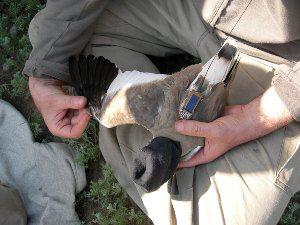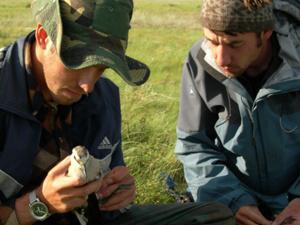Paul Donald
This project aims to discover the migration routes and wintering grounds of the eastern flyway population of the critically endangered Sociable Lapwing.

The Sociable Lapwing is a migratory bird listed by IUCN as Critically Endangered because of severe population declines. The species breeds on the Central Asian steppes, mostly in Kazakhstan. Research by the BirdLife Partners in UK, Kazakhstan and Russia has revealed much about the species’ breeding distribution and breeding success. The latter appears to be high, suggesting that the causes of decline lie on the migration routes or wintering grounds. However, too little is known of either for effective conservation action to be developed. Historical records suggest the existence of two wintering populations, a western population wintering from the Middle East, East Africa and the Arabian Peninsula, and an eastern population wintering in India and Pakistan.

Recent collaborative work using colour ringing and satellite tracking is starting to elucidate the western migration routes and wintering areas, but the more threatened eastern population remains virtually unknown. This project aims to identify the migration routes, wintering areas, threats and habitat use of the eastern population by replicating recent collaborative successes by BirdLife Partners using satellite technology to study the western population. This will allow the development of a global conservation strategy for this species, and will generate vital information for the forthcoming update of the Species Action Plan. This is particularly important, as the eastern population appears to have suffered greater declines than the western population. Methods developed in the study of the western population, which involve tracking individual birds with satellite tags and sending the data to local field teams to follow and study the flocks on the ground, are already generating information on threats and key sites that BirdLife Partners in Turkey and Syria are using to monitor and conserve the species. This method led to the discovery in October 2007 in eastern Turkey of the largest flock of birds ever recorded. Involving BirdLife Partners and other contacts in Pakistan and India (and possibly other countries) in the same way will build a conservation strategy for this species in all its range states, a unique achievement in this part of the world.
We will fit 9.5g satellite tags to two birds in the easternmost breeding populations of the species in Kazakhstan during the 2008 breeding season. locations of the tagged birds will be tracked during their southwards migration and BirdLife Partners and other contacts informed of their locations. When the birds appear to be settled in a particular location, we will endeavour to get local field teams to those sites to count the flocks that the tagged birds are in, assess whether there are any obvious threats (particularly hunting) and the habitats the birds are using, and look for colour-ringed birds. As the species migrates in flocks, following a small number of tagged individuals can lead to the discovery of large numbers of birds. The birds will be tracked to their wintering grounds, then back again the following spring to their breeding grounds.